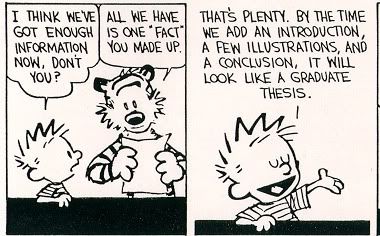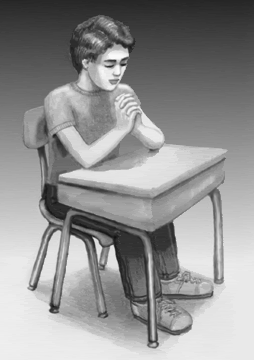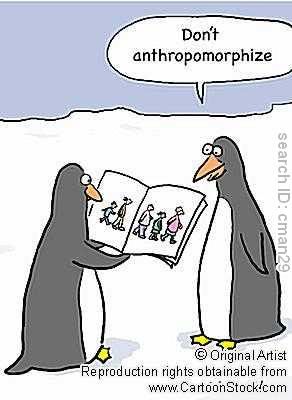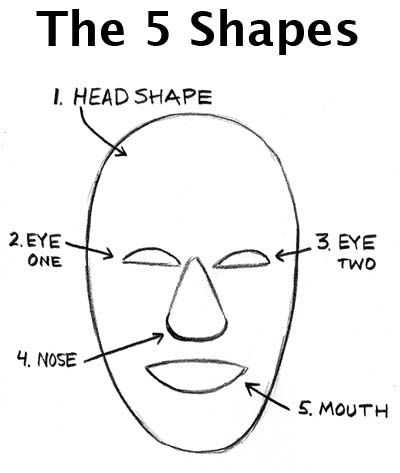I enjoyed this writing project immensely. Ever since I was a young child I would pour through books of Garfield, Calvin and Hobbes, Peanuts, and Zits. I enjoyed learning the technical mechanics of comics and how they applied to “Math Atheist.” However, this project was also a challenge because of my lack of artistic experience. Because I have no background in the art of cartooning, it was difficult for me to find the specific argument the strip is making.
This challenge is made obvious by the biggest change I made between the statement of purpose and final draft. Specifically, the entire thesis statement changed. In my statement of purpose, I wrote that Watterson is telling the United States to take the separation of church and state less seriously. I overanalyzed the strip and missed the argument “Math Atheist” is truly making—that children want to avoid doing their homework. Thus, I changed the thesis statement of the essay.
In my statement of purpose, I also stated I would be addressing arguments against the conventions of modern cartooning. I still believe these arguments are inherent to Calvin and Hobbes. A brief examination of the history of Watterson and his work will make this obvious. However, I decided pursuing two different lines of argumentation for such a short essay would be too difficult. I would have insufficient time to analyze the primary argument of familial relationships.
From the first draft to the final draft, the biggest change I made was to the thesis itself. I first made it more understandable and less awkward. I also made the thesis more general by changing the phrase “kids will be kids; adults will be adults” to a discussion of the parody of familial relationships. I also added a short discussion about how preposterous it was for Hobbes to play the role of parents in this strip. In other words, childhood incarnate plays the counterpart of childhood itself.
Also significant was what I decided not to change. In the suggestions from my instructor, it was suggested I include a section on Calvin’s use of ad hoc, or confusing cause and effect. However, I decided not to include such a discussion because it would have taken a significant amount of explanation. This would have put me over the word limit (the final draft has 1405 words) and hindered the flow of the essay.
It was also suggested I move the discussion of Calvin’s use of red herring to an earlier paragraph. However, I concluded this would also hinder the flow of the essay. I intentionally crafted the discussion of rhetoric to mirror the four panels of “Math Atheist.” The reveal in the fourth panel (and thus the discussion of red herring) would be preceded by the speech about the separation of church and state. Thus, moving the discussion of red herring to an earlier paragraph would destroy the parallelism. For the sake of clarity, however, I mentioned the logical fallacies in the thesis statement.
Statement of Purpose
Rough Draft #1
Rough Draft #2
Final Draft:
 Every teacher and student knows (and probably uses) the excuses. “My dog ate my homework.” “I got sick, but then I was better when I woke up, so my mom made me come to school.” Or, the most common in the 21st century, “My computer crashed.” Every child wants to avoid homework and will often spend more time inventing a way to avoid the homework than the homework requires in the first place. This strip of Calvin and Hobbes, known to fans as “Math Atheist,” is a parody of childhood inventiveness in avoiding homework and a parent’s sarcastic response. “Math Atheist” employs rhetoric, anthropomorphism, and simplicity to present a parody of childhood and parenting. In order to further the rhetorical argument, the strip also employs logical fallacies, appeals to logos and pathos and visual non-sequitur.
Every teacher and student knows (and probably uses) the excuses. “My dog ate my homework.” “I got sick, but then I was better when I woke up, so my mom made me come to school.” Or, the most common in the 21st century, “My computer crashed.” Every child wants to avoid homework and will often spend more time inventing a way to avoid the homework than the homework requires in the first place. This strip of Calvin and Hobbes, known to fans as “Math Atheist,” is a parody of childhood inventiveness in avoiding homework and a parent’s sarcastic response. “Math Atheist” employs rhetoric, anthropomorphism, and simplicity to present a parody of childhood and parenting. In order to further the rhetorical argument, the strip also employs logical fallacies, appeals to logos and pathos and visual non-sequitur.Calvin and Hobbes was one of the most popular comic strips of the late 1980s and early 1990s, winning two awards for excellence in comics. (NCS) The popularity of the strip has spawned tens of collections and anthologies, which are widely read to this day. (Calvin and Hobbes Album) In other words, almost everyone knows what the strip Calvin and Hobbes is and understands it is supposed to be a funny, sarcastic newspaper comic strip. Thus, the audience comes to “Math Atheist” with a certain set of expectations. It is supposed to funny, an expectation which Bill Watterson, the artist, understands. In “Math Atheist,” however, those expectations are not fulfilled until the very last panel.

The rhetoric of “Math Atheist” makes the main argument, while the various technical elements discussed later amplify and universalize this message. The scene starts out simply enough with a boy (Calvin) doing his math homework at his desk. This is a recurring theme in Calvin and Hobbes, and the audience should expect Calvin to simply refuse or give up on his homework, as is his habit. (grymonpre.com) However, this time Watterson defies the norm of Calvin’s behavior and instead launches into an impassioned, logical (though inherently flawed) speech about how math is a religion. Math is not science but religion, Calvin claims, and there is a math “god” performing miracles. You either believe in math or you don’t. You have to take it by faith, and that makes it a religion. He appears completely convinced of his own position. It appears this is a matter of utmost importance to Calvin. The separation of church and state must be upheld! Through these appeals to logos, “Math Atheist” defies the conventions we have come to expect from Calvin and Hobbes.
In the fourth panel comes the reveal: “As a math atheist, I should be excused from this.” The whole speech and line of reasoning is an excuse to get out of his homework. A
 s one observer remarked when he saw this comic, it is “The greatest ‘my dog ate my homework’ of all time.” He has created a preposterous religious system with math as a god and declared himself a math atheist just to get out of doing the math. Through this, “Math Atheist” intentionally uses the logical fallacy of red herring (bringing up unrelated issues in order to distract the opposition from the topic at hand) in order to further the argument of the piece. In other words, Watterson used flawed logic and false appeals to logos in order to set up his parody of childhood and his overall appeal to pathos.
s one observer remarked when he saw this comic, it is “The greatest ‘my dog ate my homework’ of all time.” He has created a preposterous religious system with math as a god and declared himself a math atheist just to get out of doing the math. Through this, “Math Atheist” intentionally uses the logical fallacy of red herring (bringing up unrelated issues in order to distract the opposition from the topic at hand) in order to further the argument of the piece. In other words, Watterson used flawed logic and false appeals to logos in order to set up his parody of childhood and his overall appeal to pathos.Also important to the argument of “Math Atheist” is the tiger’s (Hobbes) response to the speech. The sarcastic comment about getting a lawyer with Hobbes’ neutral (rather than convinced) facial expression gives Hobbes the role of parent. Throughout the years Watterson wrote Calvin and Hobbes, Hobbes always played the role of sensible counterpart to Calvin’s antics. As Calvin’s role is parodying a child’s avoiding homework, Hobbes is parodying a parent’s role in the situation. While it may appear Hobbes is agreeing with Calvin, a close examination of Hobbes’ facial expression (when compared to his facial expressions in other strips), it becomes clear Hobbes is actually saying Calvin’s argument is ridiculous. Hobbes is basically saying, “Yeah right.” “Math Atheist” makes an undeniable argument of parent and child.
The rhetorical blending of the serious and humorous, political and personal, also furthers the argument of “Math Atheist.” The audience expects humor for Calvin and Hobbes, an expectation which is suddenly confused by a discussion of the separation of church and state. It is a very adult topic for a six year old to discuss, and there is a risk of offending audience members by using such serious content. However, the reveal shows the intent of “Math Atheist.” It is not attempting to comment on the socio-political aspects of constitutional interpretation, but instead to parody the typical American family.
“Math Atheist” makes a clear humorous argument, but in order for the argument to be universally understood, it must be universally understandable. Several key technical elements universalize and emphasize the argument.
First, and most obviously, “Math Atheist” employs anthropomorphism. Anthropomorphism is essentially applying human characteristics to animals. It is obvious the tiger (Hobbes) is not a human, yet he tal ks, thinks, reasons, and understands the concept of separation of church and state just as well as the boy (Calvin) does. “Math Atheist” accomplishes two things by employing this device. First, it forces the audience to suspend disbelief. The audience knows stuffed tigers cannot talk in real life. However, by showing a stuffed tiger doing just that “Math Atheist” forces the audience to put aside its preconceived notions of the world. This allows the audience to accept that a six year old understands the nuances of the separation of church and state. This suspension of disbelief gives the audience accessibility to the subject matter. Second, the use of anthropomorphism gives the audience a way to relate to Calvin and Hobbes. Almost every child had a stuffed animal or doll as a “pet.” Therefore, by using anthropomorphism, "Math Atheist" both allows the audience to both believe the scene and connect with the dialogue. In addition to universalizing the argument, the use of Hobbes as the parental figure also furthers the humor of the argument. A “living” stuffed tiger, the very incarnation of childhood, is the medium through which childishness is mocked.
ks, thinks, reasons, and understands the concept of separation of church and state just as well as the boy (Calvin) does. “Math Atheist” accomplishes two things by employing this device. First, it forces the audience to suspend disbelief. The audience knows stuffed tigers cannot talk in real life. However, by showing a stuffed tiger doing just that “Math Atheist” forces the audience to put aside its preconceived notions of the world. This allows the audience to accept that a six year old understands the nuances of the separation of church and state. This suspension of disbelief gives the audience accessibility to the subject matter. Second, the use of anthropomorphism gives the audience a way to relate to Calvin and Hobbes. Almost every child had a stuffed animal or doll as a “pet.” Therefore, by using anthropomorphism, "Math Atheist" both allows the audience to both believe the scene and connect with the dialogue. In addition to universalizing the argument, the use of Hobbes as the parental figure also furthers the humor of the argument. A “living” stuffed tiger, the very incarnation of childhood, is the medium through which childishness is mocked.
The second element “Math Atheist” employs is simplicity. Except for the lamp in the fourth frame, there are no extraneous illustrations. Even the chair “disappears” during Calvin’s monologue in the third panel. The table in the foreground in the first panel also has no properties except as a visual “spine” for the panel. This simplicity of artistry gives adds to the universalism of the strip in two ways. First, the lack of “artistic clutter” amplifies the message of the strip. Any extra drawings would serve no purpose than distract the reader from the message. Second, the large empty spaces give the audience a blank slate upon which to write its own interpretation.

In addition to the lack of background and foreground, the characters’ features are drawn very simply. Calvin’s face consists of an incomplete outline, a black spot for his mouth (with a tongue), simple eyes, and lines for his forehead and eyebrows. As Scott McCloud states in The Vocabulary of Comics, “When we abstract an image through cartooning we’re not so much eliminating details as focusing on specific details.” (McCloud, 201) The abstraction of Calvin’s face allows the audience to focus on his emotion and facial expressions. Like a debater passionately arguing his point, Calvin raises his eyebrows as he pleads his case for separation of the math religion and state. Like a distant audience member, Hobbes wears a quizzical expression as Calvin lays a preposterous argument. The simplistic and unrealistic nature of the drawings allow the audience to access and focus on these emotions and amplifies the logos and pathos of “Math Atheist.”
Calvin and Hobbes captured the essence of childhood. As the rhetorical appeals of “Math Atheist” unfolds, the appeals to logos and juxtapositions of rhetorical contexts create an alteration of expectations in the audience. Finally, the expectations of the audience, humor, are fulfilled. Calvin reveals his entire speech has been a ploy to get out of homework, while his stuffed tiger plays the parental role. Through simplicity and anthropomorphism “Math Atheist” creates a universal argument everyone can understand. Children will always attempt to get out of homework, and parents will always be there to keep them on track.
The rhetorical blending of the serious and humorous, political and personal, also furthers the argument of “Math Atheist.” The audience expects humor for Calvin and Hobbes, an expectation which is suddenly confused by a discussion of the separation of church and state. It is a very adult topic for a six year old to discuss, and there is a risk of offending audience members by using such serious content. However, the reveal shows the intent of “Math Atheist.” It is not attempting to comment on the socio-political aspects of constitutional interpretation, but instead to parody the typical American family.
“Math Atheist” makes a clear humorous argument, but in order for the argument to be universally understood, it must be universally understandable. Several key technical elements universalize and emphasize the argument.
First, and most obviously, “Math Atheist” employs anthropomorphism. Anthropomorphism is essentially applying human characteristics to animals. It is obvious the tiger (Hobbes) is not a human, yet he tal
 ks, thinks, reasons, and understands the concept of separation of church and state just as well as the boy (Calvin) does. “Math Atheist” accomplishes two things by employing this device. First, it forces the audience to suspend disbelief. The audience knows stuffed tigers cannot talk in real life. However, by showing a stuffed tiger doing just that “Math Atheist” forces the audience to put aside its preconceived notions of the world. This allows the audience to accept that a six year old understands the nuances of the separation of church and state. This suspension of disbelief gives the audience accessibility to the subject matter. Second, the use of anthropomorphism gives the audience a way to relate to Calvin and Hobbes. Almost every child had a stuffed animal or doll as a “pet.” Therefore, by using anthropomorphism, "Math Atheist" both allows the audience to both believe the scene and connect with the dialogue. In addition to universalizing the argument, the use of Hobbes as the parental figure also furthers the humor of the argument. A “living” stuffed tiger, the very incarnation of childhood, is the medium through which childishness is mocked.
ks, thinks, reasons, and understands the concept of separation of church and state just as well as the boy (Calvin) does. “Math Atheist” accomplishes two things by employing this device. First, it forces the audience to suspend disbelief. The audience knows stuffed tigers cannot talk in real life. However, by showing a stuffed tiger doing just that “Math Atheist” forces the audience to put aside its preconceived notions of the world. This allows the audience to accept that a six year old understands the nuances of the separation of church and state. This suspension of disbelief gives the audience accessibility to the subject matter. Second, the use of anthropomorphism gives the audience a way to relate to Calvin and Hobbes. Almost every child had a stuffed animal or doll as a “pet.” Therefore, by using anthropomorphism, "Math Atheist" both allows the audience to both believe the scene and connect with the dialogue. In addition to universalizing the argument, the use of Hobbes as the parental figure also furthers the humor of the argument. A “living” stuffed tiger, the very incarnation of childhood, is the medium through which childishness is mocked.The second element “Math Atheist” employs is simplicity. Except for the lamp in the fourth frame, there are no extraneous illustrations. Even the chair “disappears” during Calvin’s monologue in the third panel. The table in the foreground in the first panel also has no properties except as a visual “spine” for the panel. This simplicity of artistry gives adds to the universalism of the strip in two ways. First, the lack of “artistic clutter” amplifies the message of the strip. Any extra drawings would serve no purpose than distract the reader from the message. Second, the large empty spaces give the audience a blank slate upon which to write its own interpretation.

In addition to the lack of background and foreground, the characters’ features are drawn very simply. Calvin’s face consists of an incomplete outline, a black spot for his mouth (with a tongue), simple eyes, and lines for his forehead and eyebrows. As Scott McCloud states in The Vocabulary of Comics, “When we abstract an image through cartooning we’re not so much eliminating details as focusing on specific details.” (McCloud, 201) The abstraction of Calvin’s face allows the audience to focus on his emotion and facial expressions. Like a debater passionately arguing his point, Calvin raises his eyebrows as he pleads his case for separation of the math religion and state. Like a distant audience member, Hobbes wears a quizzical expression as Calvin lays a preposterous argument. The simplistic and unrealistic nature of the drawings allow the audience to access and focus on these emotions and amplifies the logos and pathos of “Math Atheist.”
Calvin and Hobbes captured the essence of childhood. As the rhetorical appeals of “Math Atheist” unfolds, the appeals to logos and juxtapositions of rhetorical contexts create an alteration of expectations in the audience. Finally, the expectations of the audience, humor, are fulfilled. Calvin reveals his entire speech has been a ploy to get out of homework, while his stuffed tiger plays the parental role. Through simplicity and anthropomorphism “Math Atheist” creates a universal argument everyone can understand. Children will always attempt to get out of homework, and parents will always be there to keep them on track.
Works Cited:
National Cartoonists Society, "The Reuben Award 1975 onwards." (c) 2005
Fisher-Cox, Adam, "The Calvin and Hobbes Album," (c) 2008
Grymonpre.com, "Calvin & Hobbes Math Homework Advice," April, 2006
McCloud, Scott, The Vocabulary of Comics, pg 201
No comments:
Post a Comment